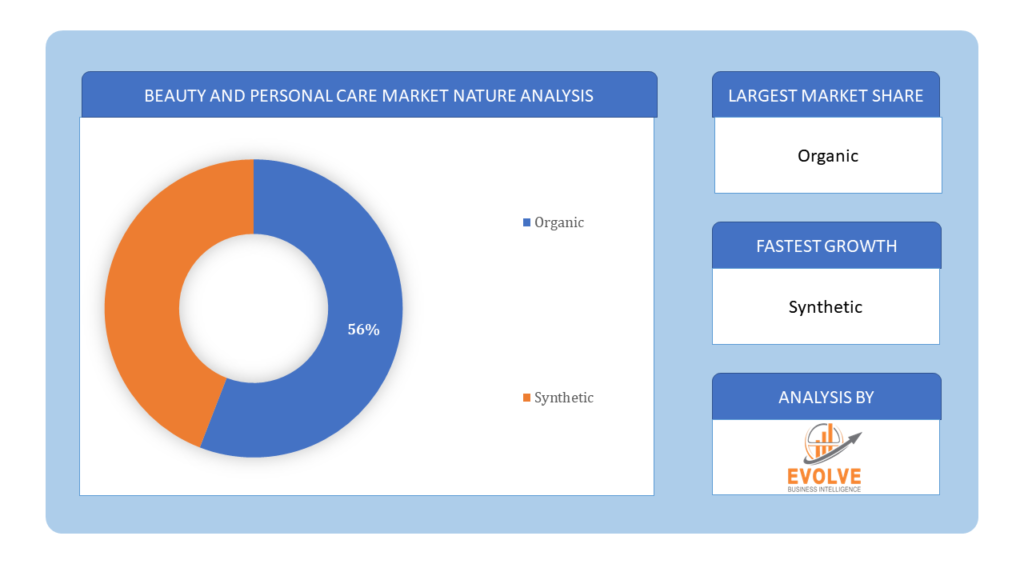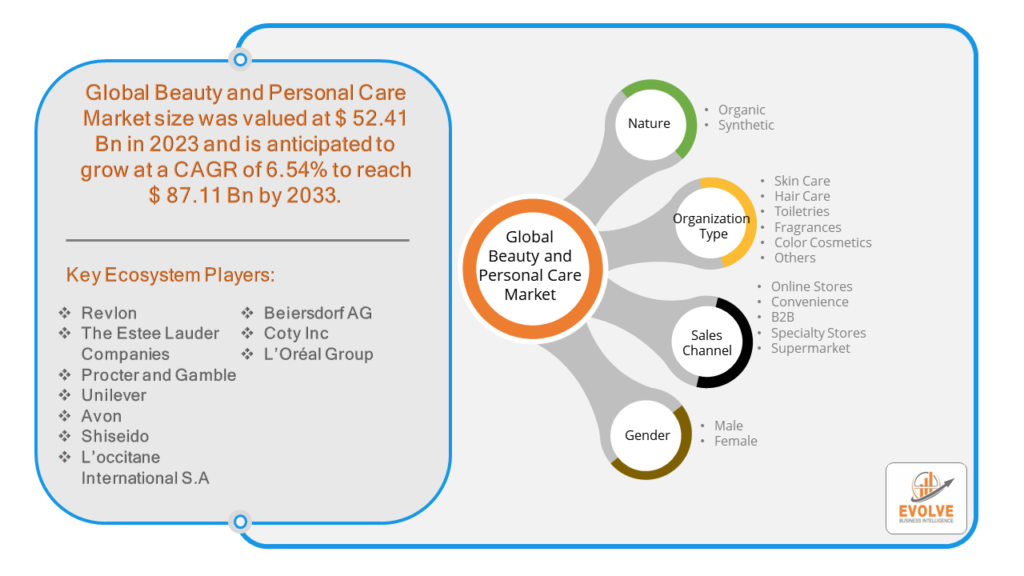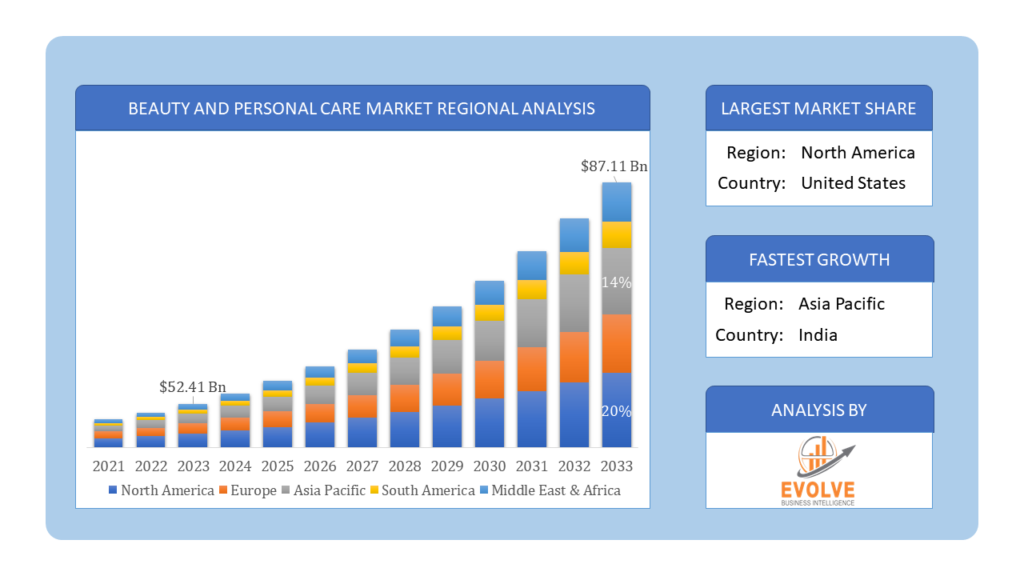Beauty and Personal Care Market Overview
The Beauty and Personal Care Market Size is expected to reach USD 87.11 Billion by 2033. The Beauty and Personal Care Market industry size accounted for USD 52.41 Billion in 2023 and is expected to expand at a compound annual growth rate (CAGR) of 6.54% from 2023 to 2033. The Beauty and Personal Care Market encompasses a wide range of products and services aimed at enhancing physical appearance and personal hygiene. This market is driven by factors such as increasing consumer awareness about personal grooming, the influence of social media and beauty trends, technological advancements in product formulation, and growing disposable incomes.
It is also influenced by the demand for natural and organic products, anti-aging solutions, and products tailored for specific demographics, such as men’s grooming products and beauty products for diverse skin tones.
Global Beauty and Personal Care Market Synopsis
The COVID-19 pandemic had a significant impact on the Beauty and Personal Care Market. With lockdowns and social distancing measures, many consumers reduced their spending on beauty products, particularly makeup, as social events and in-person interactions decreased. Many physical stores were temporarily closed, leading to a drop in in-store sales. This affected brands that relied heavily on brick-and-mortar retail. Consumers prioritized essential items over non-essential beauty products, impacting sales of luxury and discretionary beauty products. With more time spent at home, there was a surge in demand for skincare and self-care products as consumers focused on wellness and at-home treatments. Online sales of beauty products increased significantly as consumers shifted to online shopping. Brands that had strong e-commerce platforms or quickly adapted to digital sales channels saw growth.
Beauty and Personal Care Market Dynamics
The major factors that have impacted the growth of Beauty and Personal Care Market are as follows:
Drivers:
Ø Technological Advancements
Consumers are becoming more knowledgeable about the ingredients and benefits of beauty products, leading to informed purchasing decisions. Increased focus on health and wellness has driven demand for products that promote skin health and overall well-being. Advances in product formulations, such as anti-aging ingredients, long-lasting cosmetics, and multifunctional products, attract consumers. The integration of technology in beauty devices (e.g., facial cleansing brushes, LED therapy masks) enhances the consumer experience. Social media influencers and beauty bloggers play a significant role in shaping consumer preferences and trends. Accessible online content helps consumers learn about and feel confident in using new products. Online shopping offers convenience, a wide range of products, and personalized recommendations, driving consumer engagement and sales.
Restraint:
- Perception of Economic Instability
Economic downturns can lead to reduced consumer spending on non-essential items, including beauty and personal care products. Dependency on specific raw materials can lead to supply chain vulnerabilities and production delays. The presence of numerous brands and products can lead to market saturation, making it difficult for new entrants to establish a foothold. Rapid changes in beauty trends and consumer preferences require constant innovation and adaptation, which can be resource-intensive. Building and maintaining brand loyalty in a highly competitive market can be challenging, especially with the rise of new and niche brands.
Opportunity:
⮚ Growing demand for E-commerce Expansion
Continued growth in online shopping presents opportunities for brands to reach a broader audience through digital platforms. Leveraging DTC models can increase profit margins and foster direct customer relationships. Increasing demand for sustainable and eco-friendly products provides opportunities for brands to innovate with green formulations and packaging. Promoting transparency in ingredient sourcing and ethical practices can attract environmentally conscious consumers. The trend towards holistic health and wellness can be tapped by offering products that promote overall well-being, such as skincare with wellness benefits.
Beauty and Personal Care Market Segment Overview
By Nature
 Based on Nature, the market is segmented based on Organic and Synthetic. The Organic segment dominant the market. Organic beauty products are often produced in a way that is more environmentally friendly, promoting sustainable farming practices and reducing the carbon footprint.
Based on Nature, the market is segmented based on Organic and Synthetic. The Organic segment dominant the market. Organic beauty products are often produced in a way that is more environmentally friendly, promoting sustainable farming practices and reducing the carbon footprint.
By Organization Type
Based on Organization Type, the market segment has been divided into the Skin Care, Hair Care, Toiletries, Fragrances, Color Cosmetics and Others. The Skin Care segment has largest global market. Products aimed is to hydrating the skin to prevent dryness and maintain a healthy skin barrier. These can range from lightweight lotions to rich creams. It encompassing a wide array of products designed to maintain and improve the health and appearance of the skin
By Sales Channel
Based on Sales Channel, the market segment has been divided into the Online Stores, Convenience, B2B, Specialty Stores and Supermarket. Supermarkets segment has the largest market share. The convenience and one-stop shopping experience offered by supermarkets and hypermarkets make them a popular retail channel among individuals. Consumers appreciate the ability to browse a wide array of products under one roof, making it easy to compare brands and prices. In addition to this, these retail outlets often provide promotional offers and discounts, incentivizing shoppers to purchase beauty and personal care items while doing their regular grocery shopping.
By Gender
Based on Gender, the market segment has been divided into the Male and Female. female represented the largest segment. The evolving societal norms and increased awareness of self-care are fueling the demand for beauty and personal care products among females. In recent years, there has been a significant shift towards inclusivity and breaking traditional gender stereotypes, encouraging people of all genders to take care of their appearance and well-being. As a result, beauty and personal care brands have started offering more gender-neutral and gender-specific products, catering to a diverse range of consumers.
Global Beauty and Personal Care Market Regional Analysis
Based on region, the global Beauty and Personal Care Market has been divided into North America, Europe, Asia-Pacific, the Middle East & Africa, and Latin America. North America is projected to dominate the use of the Beauty and Personal Care Market followed by the Asia-Pacific and Europe regions.
 North America Market
North America Market
North America holds a dominant position in the Beauty and Personal Care Market. North America has high demand for premium and innovative beauty products. Social media and influencer marketing play a significant role in consumer purchasing decisions. Wide range of products catering to various skin tones and hair types.
Asia-Pacific Market
The Asia-Pacific region has indeed emerged as the fastest-growing market for the Beauty and Personal Care Market industry. Asia-Pacific is Fastest-growing market with increasing urbanization and rising disposable incomes. Strong influence of Korean and Japanese beauty trends. China is the powerhouse in this region, driven by factors like rising disposable income and a growing middle class.
Competitive Landscape
The global Beauty and Personal Care Market is highly competitive, with numerous players offering a wide range of software solutions. The competitive landscape is characterized by the presence of established companies, as well as emerging startups and niche players. To increase their market position and attract a wide consumer base, the businesses are employing various strategies, such as product launches, and strategic alliances.
Prominent Players:
- Revlon
- The Estee Lauder Companies
- Procter and Gamble
- Unilever
- Avon
- Shiseido
- L’occitane International S.A
- Beiersdorf AG
- Coty Inc
- L’Oréal Group
Key Development
In August 2023, Kao Corporation announced that it had signed an agreement to acquire the Bondi Sands, a renowned Australian sun product company that specializes in self-tanning, suncare, skincare, and body products.
In March 2023, Gillette Venus, a wholly owned subsidiary of Procter & Gamble launched its first-ever dermaplaning skincare regimen, complete with a trio of products for an easy three-step dermaplaning routine.
Scope of the Report
Global Beauty and Personal Care Market, by Nature
- Organic
- Synthetic
Global Beauty and Personal Care Market, by Organization Type
- Skin Care
- Hair Care
- Toiletries
- Fragrances
- Color Cosmetics
- Others
Global Beauty and Personal Care Market, by Sales Channel
- Online Stores
- Convenience
- B2B
- Specialty Stores
- Supermarket
Global Beauty and Personal Care Market, by Gender
- Male
- Female
Global Beauty and Personal Care Market, by Region
- North America
- US
- Canada
- Mexico
- Europe
- UK
- Germany
- France
- Italy
- Spain
- Benelux
- Nordic
- Rest of Europe
- Asia Pacific
- China
- Japan
- South Korea
- Indonesia
- Austalia
- Malaysia
- India
- Rest of Asia Pacific
- South America
- Brazil
- Argentina
- Rest of South America
- Middle East & Africa
- Saudi Arabia
- UAE
- Egypt
- South Africa
- Rest of Middle East & Africa
| Parameters | Indicators |
|---|---|
| Market Size | 2033: $87.11 Billion |
| CAGR | 6.54% CAGR (2023-2033) |
| Base year | 2022 |
| Forecast Period | 2023-2033 |
| Historical Data | 2021 |
| Report Coverage | Revenue Forecast, Competitive Landscape, Growth Factors, and Trends |
| Key Segmentations | Nature, Organization Type, Sales Channel, Gender |
| Geographies Covered | North America, Europe, Asia-Pacific, Latin America, Middle East, Africa |
| Key Vendors | Revlon, The Estee Lauder Companies, Procter and Gamble, Unilever, Avon, Shiseido, L’occitane International S.A, Beiersdorf AG, Coty Inc and L’Oréal Group |
| Key Market Opportunities | • Growing demand for E-commerce Expansion • Sustainability and Green Beauty |
| Key Market Drivers | • Technological Advancements • Digital and Social Media Influence |
REPORT CONTENT BRIEF:
- High-level analysis of the current and future Beauty and Personal Care Market trends and opportunities
- Detailed analysis of current market drivers, restraining factors, and opportunities in the future
- Beauty and Personal Care Market historical market size for the year 2021, and forecast from 2023 to 2033
- Beauty and Personal Care Market share analysis at each product level
- Competitor analysis with detailed insight into its product segment, Government & Defense strength, and strategies adopted.
- Identifies key strategies adopted including product launches and developments, mergers and acquisitions, joint ventures, collaborations, and partnerships as well as funding taken and investment done, among others.
- To identify and understand the various factors involved in the global Beauty and Personal Care Market affected by the pandemic
- To provide a detailed insight into the major companies operating in the market. The profiling will include the Government & Defense health of the company’s past 2-3 years with segmental and regional revenue breakup, product offering, recent developments, SWOT analysis, and key strategies.








